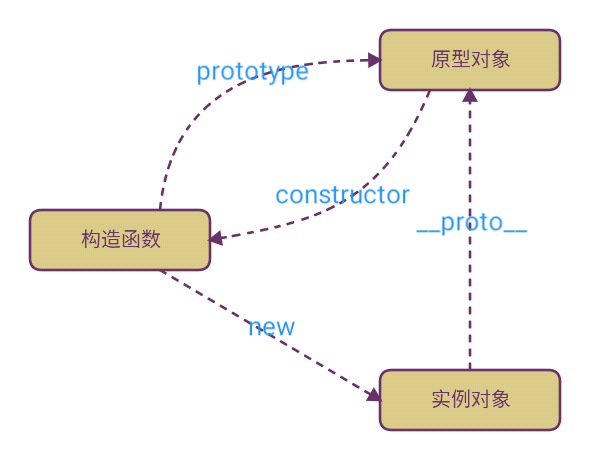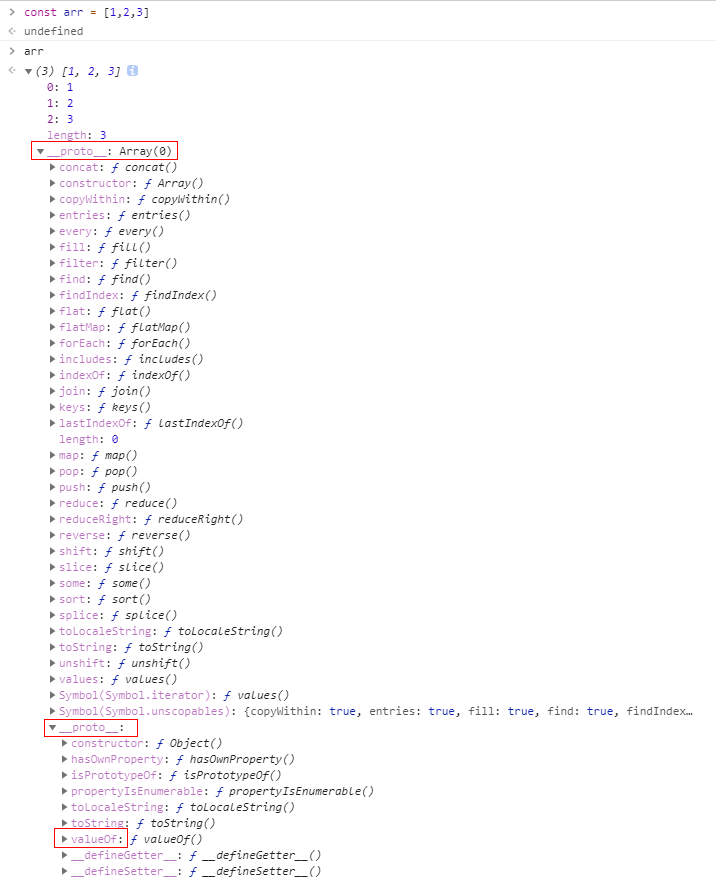【js 进阶】十分钟搞懂 JavaScript 中的 原型(prototype)、原型链、继承
前言
大家好,我是雪月。这篇文章主要讲原型(prototype)、原型链 和 原型继承。
开始(四个概念、一个例外、三个方法)
- 每个
引用类型都有对象特征,都可以自由扩展属性 - 每个
引用类型都有一个__proto__属性,并且指向它的构造函数的prototype属性 - 每个
构造函数都有一个prototype属性 - 每个
构造函数的prototype属性里的constructor指向构造函数本身 - 例外:
Object.create(null)新建的对象没有__proto__属性 - 使用
hasOwnProperty()来检查对象自身中是否含有该属性 - 使用
in检查对象中是否含有某个属性时,如果对象中没有但是原型链中有,也会返回true - 使用
instanceof运算符测试构造函数的prototype属性是否出现在对象原型链中
概念一
- 每个
引用类型都有对象特征,都可以自由扩展属性 - 查看代码
js
const obj = {}
const arr = []
const fn = function () {}
obj.a = '雪月'
arr.b = '雪月欧巴'
fn.c = '雪月欧尼酱'
console.log(obj.a) // 雪月
console.log(arr.b) // 雪月欧巴
console.log(fn.c) // 雪月欧尼酱概念二
- 每个
引用类型都有一个__proto__属性,并且指向它的构造函数的prototype原型对象 - 查看代码
js
const obj = {}
const arr = []
const fn = function () {}
console.log(obj.__proto__ === Object.prototype) // true
console.log(arr.__proto__ === Array.prototype) // true
console.log(fn.__proto__ === Function.prototype) // true概念三
- 每个
构造函数都有一个prototype原型对象 - 查看代码
js
const { log } = console
log(Object.prototype)
log(Array.prototype)
log(Function.prototype)
概念四
- 每个
构造函数的prototype原型对象里的constructor指向构造函数本身 - 查看代码
js
Object.prototype.constructor === Object // true
Array.prototype.constructor === Array // true
Function.prototype.constructor === Function // true
一个例外
Object.create(null)新建的对象没有__proto__属性
js
Object.create(null) // {}
// No properties三个方法
- 使用
hasOwnProperty()来检查对象自身中是否含有该属性 - 使用
in检查对象中是否含有某个属性时,如果对象中没有但是原型链中有,也会返回true - 使用
instanceof运算符测试构造函数的prototype属性是否出现在对象原型链中 - 查看代码
特别注意:for in 循环仅能访问原型链中 enumerable(可枚举)的属性; in 操作符不管是否可枚举
js
const arr = []
const obj = {
name: '雪月',
age: 18,
}
obj.hasOwnProperty('name') // true
obj.hasOwnProperty('age') // true
obj.hasOwnProperty('valueOf') // false
'name' in obj // true
'age' in obj // true
'valueOf' in obj // true
'dddd' in obj // false
arr instanceof Array // true
arr instanceof Object // true
obj instanceof Object // true
obj instanceof Array // false原型链
概念:当试图访问一个对象(这里的对象指引用类型)的属性时,它不仅仅在该对象上搜寻,还会搜寻该对象的原型,以及该对象的原型的原型,依次层层向上搜索, 直到找到一个名字匹配的属性或到达原型链的末尾
看下面这段代码
js
const arr = [1, 2, 3]
arr.valueOf() // [1, 2, 3]再看这张图

上图的原型链如下
arr ---> Array.prototype ---> Object.prototype ---> null
查找valueOf大致流程
- 当前实例对象
arr,查找arr的属性或方法,找到后返回 - 没有找到,通过
arr. __proto__找到arr构造函数的prototype并且查找属性或方法,找到返回 - 没有找到,把
Array.prototype当做arr,重复以上步骤 - 当到达
Object.prototype.__proto__ === null时,查找结束 - 这就是传说中的
原型链,层层向上查找,最后还没有就返回undefined
继承
JavaScript的继承有很多种方式实现,各有不足之处,下面展开说明:
- 使用
call(只能继承属性,无法继承父类原型对象中的方法) - 借助
原型链(多个实例使用同一个原型对象) - 将上面两种
结合(前面两个问题解决,但父类构造函数会多执行一次) 组合继承的优化1(构造函数变成了父类)组合继承的优化2(寄生组合继承) (基本完美)- 使用
ES6的class的extends
使用 call
缺点: 只能继承属性,无法继承父类原型对象中的方法 查看代码
js
function Parent() {
this.name = 'parent'
}
Parent.prototype.show = function () {
console.log('show')
}
function Child() {
Parent.call(this)
this.type = 'child'
}
const c = new Child()
console.log(c) // {name: "parent", type: "child"}
c.show() // Uncaught TypeError: c.show is not a function借助原型链
缺点: 多个实例使用同一个原型对象 查看代码
js
function Parent2() {
this.name = 'parent2'
this.play = [1, 2, 3]
}
function Child2() {
this.type = 'child2'
}
Child2.prototype = new Parent2()
const c2 = new Child2()
console.log(c2) // {type: "child2"}
console.log(c2.name) // parent2
console.log(c2.play) // [1, 2, 3]看似没有问题,父类的方法和属性都能够访问,但实际上有一个潜在的不足。举个例子:
js
const c21 = new Child2()
const c22 = new Child2()
c21.play.push(4)
console.log(c22.play) // [1, 2, 3, 4]
console.log(c21.play === c22.play) // true
// 因为两个实例使用的是同一个原型对象, 所以改变c21的play属性,c22的play属性也跟着变了将上面两种结合
缺点:前面两个问题解决,但父类构造函数会多执行一次 查看代码
js
function Parent3() {
this.name = 'parent3'
this.play = [1, 2, 3]
}
function Child3() {
Parent3.call(this)
this.type = 'child3'
}
Child3.prototype = new Parent3()
const c31 = new Child3()
const c32 = new Child3()
c31.play.push(4)
console.log(c31.play) // [1, 2, 3, 4]
console.log(c32.play) // [1, 2, 3]组合继承的优化 1
缺点:构造函数变成了父类 查看代码
这里让将父类原型对象直接给到子类,父类构造函数只执行一次,而且父类属性和方法均能访问,但是子类实例的构造函数是 Parent4,显然这是不对的,应该是 Child4
js
function Parent4() {
this.name = 'parent4'
this.play = [1, 2, 3]
}
function Child4() {
Parent4.call(this)
this.type = 'child4'
}
Child4.prototype = Parent4.prototype
var c41 = new Child4()
console.log(c41)组合继承的优化 2 (寄生组合继承)
缺点:基本完美 查看代码
js
function Parent5() {
this.name = 'parent5'
this.play = [1, 2, 3]
}
function Child5() {
Parent5.call(this)
this.type = 'child5'
}
Child5.prototype = Object.create(Parent5.prototype)
Child5.prototype.constructor = Child5
const c51 = new Child5()
console.log(c51)使用 ES6 的 class 的 extends
缺点:基本完美 查看代码
js
class Parent6 {
constructor(name, age, school) {
this.name = name
this.age = age
this.school = school || '斗罗大陆'
}
show() {
console.log(this.name + this.age + '岁,' + '在' + this.school)
}
}
class Child6 extends Parent6 {
constructor(name, age, school) {
super(name, age, school)
}
}
const c61 = new Parent6('小明', 18, '五道口职业技术学院')
const c62 = new Child6('小华', 20, '北京大学')
const c63 = new Child6('小三', 22)
c61.show() // 小明18岁,在五道口职业技术学院
c62.show() // 小华20岁,在北京大学
c63.show() // 小三22岁,在斗罗大陆结束
本文从四个概念、一个例外、三个方法出发,让大家深入理解 JavaScript 中的 原型(prototype),从而引申出原型链的概念,总结了 6 个继承的方法。感谢阅读^_^